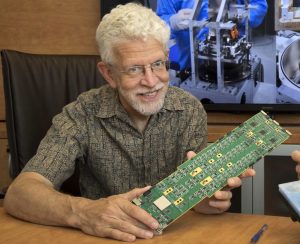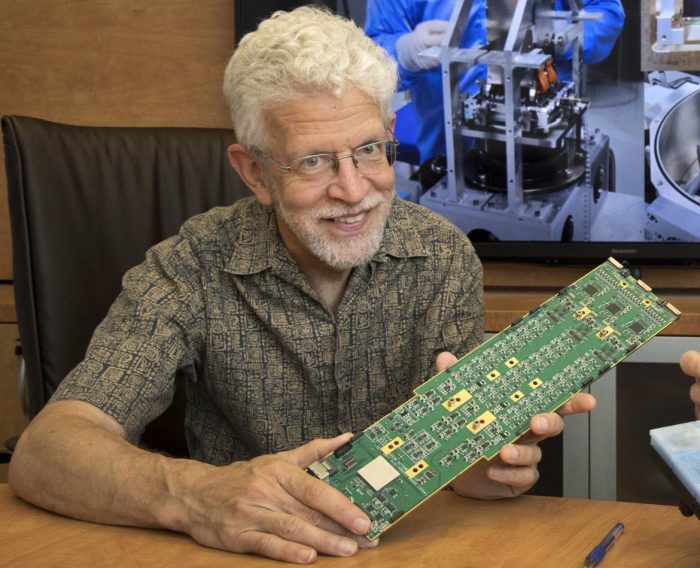By Daniel Dunaief
The Earth is way too noisy.
The far side of the moon, however, can act like enormous noise cancellation headphones, serving as a barrier to the kinds of signals from sources including Earth’s ionosphere, which carries electromagnetic noises from lightning, solar flares, radio signals, among others to look or, perhaps more appropriately, listen deep into the past.
On Wednesday, May 7, at Napper Tandy’s in Smithtown, three Brookhaven National Laboratory scientists will speak with the public about an unnamed mission expected to take off next year. The free event is part of BNL’s PubSci science café series (www.bnl.gov/pubsci/).

Senior Scientist Paul O’Connor, Mechanical Engineer Connie-Rose Deane and Physicist Anže Slosar will discuss a project called LuSEE-Night, which, like so many other efforts at BNL, is an acronym. LuSEE stands for Lunar Surface Electromagnetic Experiment-Night.
The Department of Energy project manager is Sven Hermann at Brookhaven National Laboratory. Slosar is the science lead, while O’Connor coordinated technical and systems aspects of the instrument development.
The scientists collaborated with researchers at the National Aeronautics and Space Administration and the Department of Energy and included scientists at the University of Minnesota and at the University of California, Berkeley.
The Space Science Laboratory at the University of California, Berkeley is leading the project. BNL is a collaborating member responsible for delivering hardware components of the payload.
LuSEE-Night, which is a radio telescope, is designed to gather information about the Dark Ages of the universe. This time period, from about 380,000 to 400 million years ago after the Big Bang, occurred before the first luminous stars and galaxies.

As the only signals measurable from the Dark Ages, radio waves, recorded through LuSEE-Night provide a chance to learn how the first non-luminous matter evolved into stars and galaxies.
Over the last several years, scientists at the Department of Energy and NASA have shared their excitement about seeing something they had never seen before.
David Rapetti, Senior Researcher with Universities Space Research Association (USRA) at NASA’s Ames Research Center in California’s Silicon Valley, suggested the instrument was a “trailblazer for subsequent potential single telescope experiments for the global signal, also including the Cosmic Down signal at a somewhat higher frequency range.”
Rapetti, who has been with the project since its inception, suggested that this instrument could help with plenty of other science.
“In addition to studies of the sun, planets and exoplanets, the roadmap ahead for low frequency observations from the lunar surface represents a crucial resource to further our understanding of the evolution, content and first luminous objects of the early Universe,” Rapetti explained.
A potential measurement of the global Dark Ages signal could in principle reveal “undiscovered new physics or indeed further validate the current standard model of cosmology,” Rapetti added.
Challenging conditions
When looking for a landing site, the team searched for a flat, level surface that was free of large rocks and craters and that had an unobstructed view of the sky in all directions.

They chose the Schrodinger Basin, which is about 250 miles south of the lunar equator at a point “almost exactly opposite the Earth-facing direction,” O’Connor explained. This will keep the telescope as “free as possible from electromagnetic interference from Earth,” he added.
Sending the telescope to the far side of the moon created particular challenges. For starters, the telescope had to endure the forces experienced during launch and landing. Once it was on the moon, it had to tolerate the harsh temperature that could drop as low as minus 280 degrees Fahrenheit, and radiation environment, while staying within the mass and power budgets. The instrument mass is less than 282 pounds.
While the landing site is ideal for minimizing electromagnetic noise, it’s difficult to send the information back to Earth with the moon blocking the communication.
Indeed, the ill-fated Apollo 13 mission, which was led by Commander James Lovell and that orbited the moon without landing, was out of communication for about 25 minutes while it was on the far side of the moon.
To gather data from the telescope, the group is sending a satellite that will orbit the moon, enabling communication that has a 1.3 second time delay in each direction as the signal travels to the moon.
The signal processing chain required a state-of-the-art digital chip that could crunch the data as it comes through small antennas and produces a reduced data set small enough to send back to Earth, explained O’Connor, who worked with a core BNL team of six senior scientists and engineers and about a dozen other engineers, technicians and project staff on a final design that took about 16 months to complete
Additionally, the telescope will only generate solar energy during 14 Earth days a month. During another 14 days, the instrument needs to run without recharging its battery.
To protect the telescope against the harsh, cold environment of the moon, the scientists are wrapping the instrument in many layers of an insulating blanket. The heat from its operation should provide enough energy to prevent damage from the cold.
When the radio telescope launches, the four antennas are coiled into a compact spool the size of a soda can. After landing, the latch is released, allowing the antenna to deploy into self-supporting booms three meters long using their own spring force. At this point, several research and development missions are underway to learn more about the moon in preparation for the Artemis 3 manned mission currently planned for the middle of 2027.
LSST/ Rubin Observatory
O’Connor has also been involved for over two decades with the development of a project called the Large Synoptic Survey Telescope that is now called the Vera C. Rubin Observatory in Cerro Pachón, Chile.
Rubin was an astronomer who provided the first evidence of the existence of dark matter.
The much anticipated activation of this observatory, which will allow researchers to look into billions of galaxies, asteroids and even dark matter, will start producing data in July.
O’Connor, who helped with the film part of the observatory’s camera, suggested that the BNL science team is “most interested in what LSST/ Rubin will tell us about the nature of dark energy and dark matter. This will come from analyzing the camera’s images which, paradoxically, reveal the location of dark matter as it ‘bends’ the light traveling towards us from distant regions in the universe.”
More information about the event on May 7 can be found here.





